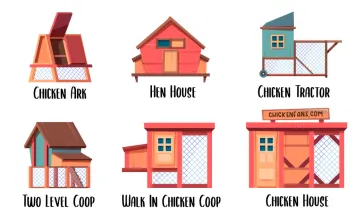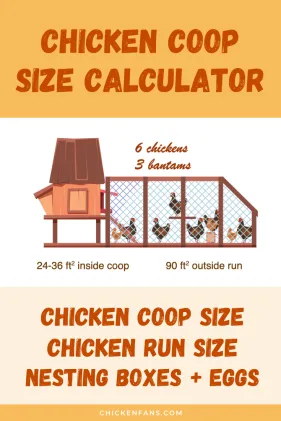Chicken Coop Size Calculator, Chicken Coop
So, you’ve decided to venture into the world of backyard chicken keeping.
Before you start building your chicken coop, it’s important to determine the right size for your feathered friends. That’s where the Chicken Coop Size Calculator comes in.
With this handy tool, you can easily calculate the ideal dimensions for your chicken coop based on the number of chickens you plan to keep.
No more guesswork or overcrowded coops! This article will walk you through the benefits of using the Chicken Coop Size Calculator and how it can ensure happy and healthy chickens in your backyard.
Factors to Consider when Designing a Chicken Coop
When it comes to designing a chicken coop, there are several factors that you need to consider in order to create a comfortable and functional living environment for your feathered friends.
From the number and size of chickens to the climate and available space, each factor plays a crucial role in determining the design and size of your coop.
Let’s delve into each of these factors and explore how they influence your chicken coop design.

This image is property of www.chickenfans.com.
Number of Chickens
The first factor to consider is the number of chickens you plan to keep.
Determining the number of chickens helps you establish the overall size of the coop and ensures that each chicken has enough space to live comfortably.
Determining the Number of Chickens
Before you start designing your chicken coop, it’s important to decide how many chickens you want to raise.
This will depend on various factors such as your personal preferences, desired egg production, or even the amount of available space. Take into account the local regulations and any restrictions regarding chicken ownership in your area.
Space Requirements per Chicken
Once you have determined the number of chickens, you need to calculate the space requirements per chicken. Different sources recommend different spaces per bird, but a general guideline is to provide a minimum of 3-4 square feet of coop space per chicken.
This allows for comfortable movement and reduces stress among the flock. However, if you have larger breeds or plan to keep them confined for longer periods of time, you might need to provide more space.
Size of Chickens
The size of your chickens is another important factor to consider when designing your coop. Different chicken breeds come in various sizes, and their space requirements will differ accordingly.
Different Chicken Breeds
There is a wide variety of chicken breeds to choose from, each with its own unique characteristics. Some breeds, like the Brahma or Jersey Giant, can reach significant sizes, while others, such as bantams, are much smaller.
When selecting your breed, take into account not only their size but also their temperament and activity level.
Average Size of Chickens
On average, most backyard chickens fall into the medium size range. These chickens typically require around 3-4 square feet of coop space per bird. However, if you decide to raise larger breeds, you might need to provide more space to ensure their comfort and well-being.
Space Requirements based on Chicken Size
In addition to the number of chickens, the size of your birds will determine the overall dimensions of your coop.
Larger chickens will require more space both horizontally and vertically to move around comfortably and access nesting boxes and perches. Additionally, bigger birds might need extra headroom to prevent injuries and ensure a stress-free environment.

This image is property of cdn.shopify.com.
Activity Level of Chickens
The activity level of your chickens also impacts the design and space requirements of your coop. Some breeds are more active and require a larger space to roam and exercise, while others tend to be more relaxed and content with smaller areas.
Activity Level of Chicken Breeds
Chickens can vary in their levels of activity. Breeds like Leghorns or Easter Eggers are known as active foragers, constantly moving around in search of food.
On the other hand, some heritage breeds, like Orpingtons or Sussex, tend to be less active and are more satisfied with smaller spaces.
See also This Is How A Covered Chicken Dust Bath Keeps Sand Dry
Space Requirements based on Activity Level
If you have highly active chicken breeds, you should provide them with more space to accommodate their need for exercise and mental stimulation.
A larger run area attached to the coop will allow them to explore and forage to their heart’s content. However, if your chickens are not particularly active or your available space is limited, you can allocate a smaller area without compromising their well-being.
Breeding or Not
Another consideration when designing a chicken coop is whether you plan to breed your chickens or not. Breeding requires additional space and facilities to ensure the safety and health of the breeding pairs and their offspring.
Additional Space for Breeding
If you intend to breed your chickens, you will need to allocate extra space within the coop or provide a separate breeding area.
This allows you to move the breeding pairs away from the rest of the flock and create a calm and protected environment for them to mate, lay eggs, and rear their young.
Separate Breeding Area
To ensure successful breeding and minimize the risk of aggression from other chickens, it’s advisable to set up a separate breeding area.
This area can be smaller in size compared to the main coop, as it will only house the breeding pairs and their offspring. It should be equipped with nesting boxes, brooding facilities, and all the necessary provisions to support the breeding process.

This image is property of i.pinimg.com.
Climate
The climate of your region plays a significant role in the design and construction of your chicken coop. Whether you live in a hot or cold climate, it’s essential to create a coop that provides adequate ventilation and insulation to keep your chickens comfortable and safe.
Hot Climate Considerations
If you reside in a hot climate, your chicken coop should be designed to provide sufficient shade and ventilation. Consider positioning your coop in a shaded area, away from direct sunlight.
Additionally, providing adequate ventilation through windows, vents, or fans will help circulate air and prevent overheating. You may also want to include features like misting systems or shade cloth to further cool down the coop during the hot summer months.
Cold Climate Considerations
In colder climates, insulation is crucial to protect your chickens from frostbite and extreme temperatures. Ensure that the walls, roof, and flooring of your coop are adequately insulated to retain heat.
Heating options, such as radiant heat panels or heat lamps, can also be installed to provide additional warmth when needed. Proper ventilation is still essential, even in cold climates, to prevent the buildup of moisture and avoid respiratory issues.
Ventilation and Insulation
Regardless of the climate, ventilation is crucial in a chicken coop to maintain good air quality and prevent the buildup of harmful gases.
Ample windows, vents, or openings should be incorporated into the coop design to allow for proper airflow.
However, it’s important to strike a balance between ventilation and insulation to ensure your chickens are neither too hot nor too cold.
Available Space
The amount of available space you have will greatly influence the design and size of your chicken coop. It’s essential to consider both the minimum space requirements and the ideal space recommendations to provide a comfortable environment for your flock.
Minimum Space Requirements
At a minimum, each chicken needs enough space to move around, stretch their wings, and access nesting boxes and perches comfortably. As mentioned earlier, a general guideline is to allocate 3-4 square feet of coop space per chicken.
However, keep in mind that this is only the minimum requirement, and additional space is always beneficial for the chickens’ overall well-being.
Ideal Space Recommendations
If you have the luxury of ample space, it’s highly recommended to provide more room for your flock. Increasing the space in the
coop and the attached run area will allow your chickens to exhibit natural behaviors, explore, and forage freely.
See also Top 5 Chicken Coop Heaters
Not only will this result in happier and healthier chickens, but it will also reduce the likelihood of stress-related issues arising within the flock.

This image is property of cdn.shopify.com.
Budget
Your budget is an important factor to consider when designing a chicken coop. It will determine the materials you use, the size of the coop, and the overall cost of construction and maintenance.
Cost of Materials and Construction
The cost of materials and construction for your chicken coop will vary depending on the size and design you choose.
Wood is a popular choice for coops, but it can be more expensive than other materials such as PVC or metal. Additionally, features like windows, nesting boxes, and ventilation systems will also impact the overall cost.
Consider your budget carefully and prioritize the essentials while keeping in mind the long-term maintenance costs as well.
Long-Term Maintenance Costs
Apart from the initial construction, it’s important to factor in the long-term maintenance costs of your chicken coop.
This includes regular cleaning, replacement of bedding and nesting materials, repairs, and any necessary upgrades. Investing in high-quality materials and solid construction initially can reduce future maintenance costs and ensure the longevity of your coop.
Accessibility
Creating a chicken coop that is easily accessible for cleaning, maintenance, and handling is essential for both your convenience and the well-being of your chickens.
Ease of Access for Cleaning and Maintenance
Your chicken coop design should incorporate features that make cleaning and maintenance tasks as effortless as possible.
This includes easy-to-access doors, removable flooring or trays for easy cleaning, and well-designed nesting boxes that are accessible from outside the coop. Accessible areas will allow you to maintain a clean and hygienic environment, reducing the risk of parasites and diseases.
Adequate Space for Handling and Feeding
In addition to cleaning, your coop should provide enough space for convenient handling of chickens and easy access for feeding and watering.
Consider design elements such as wider doorways, elevated feeding stations, and secure areas for handling individual birds. These features will not only make your daily chicken care routine more manageable but also reduce stress for both you and your chickens.

This image is property of cdn.shopify.com.
Future Expansion
Planning for the future growth of your flock is a smart move when designing a chicken coop. Anticipating future expansion allows you to create a coop that can accommodate more chickens without major modifications or the need to build an entirely new structure.
Planning for Future Growth of Flock
When designing your coop, think about the possibility of expanding your flock in the future. Leave room for additional nesting boxes, perches, and feeding stations that can be easily added as your flock grows.
Consider the overall dimensions of your coop and the available space in the attached run area to ensure future expansion is feasible.
Designing Modular or Expandable Coop
One way to facilitate future expansion is by designing a modular or expandable coop. This allows you to add new sections or modules to the existing structure as needed.
Prefabricated coop systems are available that offer flexibility and scalability to accommodate the changing needs of your flock.
Being able to easily expand your coop will save you time and effort in the long run and ensure a seamless transition as your flock grows.
In conclusion, designing a chicken coop involves careful consideration of various factors to create a comfortable and functional living space for your flock.
From determining the number of chickens and their size to account for their activity level and future breeding plans, each factor influences the dimensions and features of your coop.
Additionally, climate, available space, budget, accessibility, and plans for future growth also play important roles in the coop design.
By taking all these factors into account, you can create a chicken coop that meets the specific needs of your flock and provides a safe and enjoyable environment for your feathered friends.
